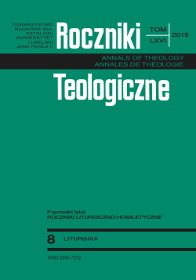Nałożenie rąk w liturgii święceń w pierwszym tysiącleciu (Część i: Starożytność chrześcijańska)
Imposition of Hands in the Liturgy of Holy Orders in the First Millennium (Part One: Christian Antiquity)
Author(s): Waldemar BartochaSubject(s): Christian Theology and Religion, Theology and Religion, Pastoral Theology
Published by: Towarzystwo Naukowe KUL & Katolicki Uniwersytet Lubelski Jana Pawła II
Keywords: imposition (laying on) of hands; ordination; Holy Spirit; bishop; presbyter, deacon
Summary/Abstract: Imposition of hands belongs to the essence of the ordination rites of bishops, presbyters and deacons, beside the ordination prayer itself. This gesture occurs in close correlation with the ordination prayer which follows it. The prayer of blessing and petition determines its meaning. The post-conciliar liturgical reform of the rites of ordination emphasized the rite of imposition of hands, thus restoring its original meaning. The aim of this article is to show the origin and theological meaning of the gesture of imposition of hands, as well as its place in the structure of ordination celebrations in the first millennium. The gesture of imposition of hands has biblical roots. In the New Testament, placing hands on a candidate meant imparting to him the charism appropriate to the office. In the ritual schema contained in the apostolic Tradition, the gesture of laying on of hands is used to entrust the office of bishop, presbyter and deacon. It plays a central role in the dynamics of the celebration of Holy Orders.
Journal: Roczniki Teologiczne
- Issue Year: 66/2019
- Issue No: 8
- Page Range: 5-22
- Page Count: 18
- Language: Polish

